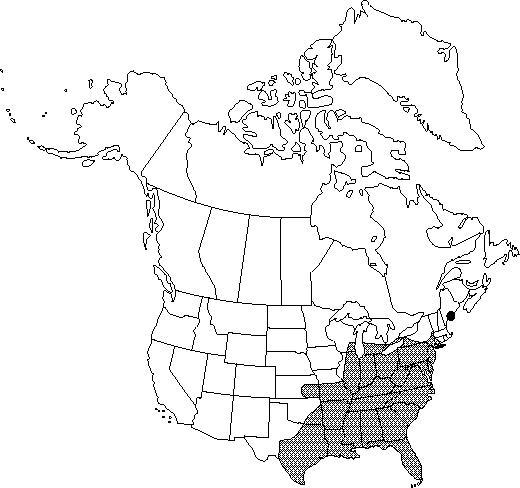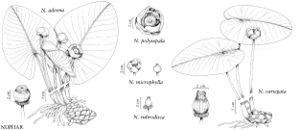Difference between revisions of "Nuphar advena"
Hortus Kew. 3: 295. 1811.
FNA>Volume Importer |
FNA>Volume Importer |
||
| Line 15: | Line 15: | ||
}} | }} | ||
|basionyms={{Treatment/ID/Synonym | |basionyms={{Treatment/ID/Synonym | ||
| − | |name= | + | |name=Nymphaea advena |
|authority=Aiton | |authority=Aiton | ||
}} | }} | ||
|synonyms={{Treatment/ID/Synonym | |synonyms={{Treatment/ID/Synonym | ||
| − | |name= | + | |name=Nuphar fluviatilis |
|authority=(R. M. Harper) Standley | |authority=(R. M. Harper) Standley | ||
| − | }}{{Treatment/ID/Synonym | + | }} {{Treatment/ID/Synonym |
| − | |name= | + | |name=Nuphar lutea subsp. advena |
|authority=(Aiton) Kartesz & Gandhi | |authority=(Aiton) Kartesz & Gandhi | ||
| − | }}{{Treatment/ID/Synonym | + | }} {{Treatment/ID/Synonym |
| − | |name= | + | |name=Nuphar lutea subsp. macrophylla |
|authority=(Small) E. O. Beal | |authority=(Small) E. O. Beal | ||
| − | }}{{Treatment/ID/Synonym | + | }} {{Treatment/ID/Synonym |
| − | |name= | + | |name=Nuphar lutea subsp. ozarkana |
|authority=(G. S. Miller & Standley) E. O. Beal | |authority=(G. S. Miller & Standley) E. O. Beal | ||
| − | }}{{Treatment/ID/Synonym | + | }} {{Treatment/ID/Synonym |
| − | |name= | + | |name=Nuphar ovata |
|authority=Fernald | |authority=Fernald | ||
| − | }}{{Treatment/ID/Synonym | + | }} {{Treatment/ID/Synonym |
| − | |name= | + | |name=Nuphar ozarkana |
|authority=G. S. Miller & Standley | |authority=G. S. Miller & Standley | ||
| − | }}{{Treatment/ID/Synonym | + | }} {{Treatment/ID/Synonym |
| − | |name= | + | |name=Nuphar puteora |
|authority=R. M. Harper | |authority=R. M. Harper | ||
| − | }}{{Treatment/ID/Synonym | + | }} {{Treatment/ID/Synonym |
| − | |name= | + | |name=Nuphar ×interfluitans |
|authority=G. S. Miller & Standley | |authority=G. S. Miller & Standley | ||
| − | }}{{Treatment/ID/Synonym | + | }} {{Treatment/ID/Synonym |
| − | |name= | + | |name=Nymphaea advena subsp. macrophylla |
|authority=(Small) G. S. Miller & Standley | |authority=(Small) G. S. Miller & Standley | ||
| − | }}{{Treatment/ID/Synonym | + | }} {{Treatment/ID/Synonym |
| − | |name= | + | |name=Nymphaea chartacea |
|authority=G. S. Miller & Standley | |authority=G. S. Miller & Standley | ||
| − | }}{{Treatment/ID/Synonym | + | }} {{Treatment/ID/Synonym |
| − | |name= | + | |name=Nymphaea fluviatilis |
|authority=G. S. Miller & Standley | |authority=G. S. Miller & Standley | ||
| − | }}{{Treatment/ID/Synonym | + | }} {{Treatment/ID/Synonym |
| − | |name= | + | |name=Nymphaea ludoviciana |
|authority=G. S. Miller & Standley | |authority=G. S. Miller & Standley | ||
| − | }}{{Treatment/ID/Synonym | + | }} {{Treatment/ID/Synonym |
| − | |name= | + | |name=Nymphaea macrophylla |
|authority=G. S. Miller & Standley | |authority=G. S. Miller & Standley | ||
| − | }}{{Treatment/ID/Synonym | + | }} {{Treatment/ID/Synonym |
| − | |name= | + | |name=Nymphaea microcarpa |
|authority=unknown | |authority=unknown | ||
| − | }}{{Treatment/ID/Synonym | + | }} {{Treatment/ID/Synonym |
| − | |name= | + | |name=Nymphaea ovata |
|authority=unknown | |authority=unknown | ||
| − | }}{{Treatment/ID/Synonym | + | }} {{Treatment/ID/Synonym |
| − | |name= | + | |name=Nymphaea ozarkana |
|authority=unknown | |authority=unknown | ||
| − | }}{{Treatment/ID/Synonym | + | }} {{Treatment/ID/Synonym |
| − | |name= | + | |name=Nymphaea puberula |
|authority=unknown | |authority=unknown | ||
}} | }} | ||
| Line 84: | Line 84: | ||
|elevation=0-450 m | |elevation=0-450 m | ||
|distribution=Ont.;Ala.;Ark.;Conn.;Del.;D.C.;Fla.;Ga.;Ill.;Ind.;Kans.;Ky.;La.;Maine;Md.;Mich.;Miss.;Mo.;N.J.;N.Y.;N.C.;Ohio;Okla.;Pa.;S.C.;Tenn.;Tex.;Vt.;Va.;W.Va.;Wis.;Mexico (Coahuila;Tamaulipas);West Indies (Cuba). | |distribution=Ont.;Ala.;Ark.;Conn.;Del.;D.C.;Fla.;Ga.;Ill.;Ind.;Kans.;Ky.;La.;Maine;Md.;Mich.;Miss.;Mo.;N.J.;N.Y.;N.C.;Ohio;Okla.;Pa.;S.C.;Tenn.;Tex.;Vt.;Va.;W.Va.;Wis.;Mexico (Coahuila;Tamaulipas);West Indies (Cuba). | ||
| − | |discussion=<p>Nuphar advena is extremely variable and intergrades with N. orbiculata, N. ulvacea, and N. sagittifolia in areas of sympatry. Intergradation with N. variegata (E. O. Beal 1956) can be observed in the mid-Atlantic region, although most floristic treatments from the area of overlap treat the two taxa as distinct species. Local variation in the Ozark Mountains and in Texas, the basis for the names Nymphaea ozarkana, N. ovata, and N. puberula, is not considered sufficient to warrant recognition.</p> | + | |discussion=<p><i>Nuphar advena</i> is extremely variable and intergrades with <i>N. orbiculata</i>, <i>N. ulvacea</i>, and <i>N. sagittifolia</i> in areas of sympatry. Intergradation with <i>N. variegata</i> (E. O. Beal 1956) can be observed in the mid-Atlantic region, although most floristic treatments from the area of overlap treat the two taxa as distinct species. Local variation in the Ozark Mountains and in Texas, the basis for the names <i>Nymphaea</i> ozarkana, N. ovata, and N. puberula, is not considered sufficient to warrant recognition.</p> |
|tables= | |tables= | ||
|references={{Treatment/Reference | |references={{Treatment/Reference | ||
| Line 103: | Line 103: | ||
|rank=species | |rank=species | ||
|parent rank=genus | |parent rank=genus | ||
| − | |synonyms= | + | |synonyms=Nuphar fluviatilis;Nuphar lutea subsp. advena;Nuphar lutea subsp. macrophylla;Nuphar lutea subsp. ozarkana;Nuphar ovata;Nuphar ozarkana;Nuphar puteora;Nuphar ×interfluitans;Nymphaea advena subsp. macrophylla;Nymphaea chartacea;Nymphaea fluviatilis;Nymphaea ludoviciana;Nymphaea macrophylla;Nymphaea microcarpa;Nymphaea ovata;Nymphaea ozarkana;Nymphaea puberula |
| − | |basionyms= | + | |basionyms=Nymphaea advena |
|family=Nymphaeaceae | |family=Nymphaeaceae | ||
|phenology=Flowering mid spring–early fall, extended farther south. | |phenology=Flowering mid spring–early fall, extended farther south. | ||
| Line 114: | Line 114: | ||
|publication year=1811 | |publication year=1811 | ||
|special status=Selected by author to be illustrated;Weedy | |special status=Selected by author to be illustrated;Weedy | ||
| − | |source xml=https://jpend@bitbucket.org/aafc-mbb/fna-data-curation.git/src/ | + | |source xml=https://jpend@bitbucket.org/aafc-mbb/fna-data-curation.git/src/8f726806613d60c220dc4493de13607dd3150896/coarse_grained_fna_xml/V3/V3_390.xml |
|genus=Nuphar | |genus=Nuphar | ||
|species=Nuphar advena | |species=Nuphar advena | ||
Revision as of 17:16, 18 September 2019
Rhizomes mostly 5-10 cm diam. Leaves mostly emersed, occasionally floating or submersed; petiole terete or adaxially slightly flattened. Leaf blade abaxially and adaxially green, broadly ovate to nearly orbiculate, 12-40 - 7-30 cm, 1-2 times as long as wide, sinus 1/3-1/2 length of midrib, lobes overlapping to divergent, often forming angle of 90° or greater; surfaces abaxially glabrous to sparsely pubescent. Flowers to 4 cm diam.; sepals mostly 6, abaxially green to adaxially yellow, rarely red-tinged toward base; petals oblong, thick; anthers 3-7 mm, longer than filaments. Fruit green, ovoid, 2-5 × 2-5 cm, moderately ribbed, slightly constricted below stigmatic disk; stigmatic disk green, occasionally reddened, 13-25 mm diam., entire to crenate; stigmatic rays 9-23, linear to lanceolate, terminating 1-3 mm from margin of disk. Seeds 3-6 mm.
Phenology: Flowering mid spring–early fall, extended farther south.
Habitat: Ponds, lakes, sluggish streams and rivers, springs, marshes, ditches, canals, sloughs, and tidal waters
Elevation: 0-450 m
Distribution

Ont., Ala., Ark., Conn., Del., D.C., Fla., Ga., Ill., Ind., Kans., Ky., La., Maine, Md., Mich., Miss., Mo., N.J., N.Y., N.C., Ohio, Okla., Pa., S.C., Tenn., Tex., Vt., Va., W.Va., Wis., Mexico (Coahuila, Tamaulipas), West Indies (Cuba).
Discussion
Nuphar advena is extremely variable and intergrades with N. orbiculata, N. ulvacea, and N. sagittifolia in areas of sympatry. Intergradation with N. variegata (E. O. Beal 1956) can be observed in the mid-Atlantic region, although most floristic treatments from the area of overlap treat the two taxa as distinct species. Local variation in the Ozark Mountains and in Texas, the basis for the names Nymphaea ozarkana, N. ovata, and N. puberula, is not considered sufficient to warrant recognition.
